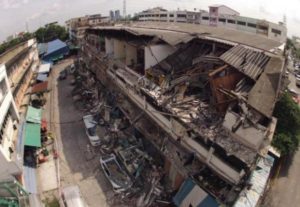
Spotting warning signs of structural damage can save lives
Cracks in the walls, jammed windows and doors, and bad drainage all point to a potential building collapse
A home with structural problems can be a nightmare, or even deadly, for homeowners especially if the foundation or main structure is damaged.
Depending on the severity of the damage, it can leave the building at risk of collapse, causing the loss of lives and possessions.
The collapse of awnings on an old residential building near Pracha Niwet Market 1 in Chatuchak district on Sept 7 is a case in point. There were no injuries, but the building was severely damaged.
The collapse was caused by increased weight due to rainwater accumulating on the awnings, and prompted authorities to unsuccessfully try to get tenants of another 18 buildings nearby to leave out of concern for their safety.
The incident raised the alarm among local experts and prompted them to provide advice to ensure homeowners know how to spot warning signs of structural problems in their homes before a collapse happens.
Engineering Institute of Thailand associate professor Anek Siripanichgorn, who is the chairman of the institute’s Civil Engineering Communication Construction Engineering department, said deep cracks in the walls can be a warning sign of structural damage which can be caused by damage to the foundations.
A crack deeper than 25mm indicates severe damage, said Assoc Prof Anek, adding it is an indicator that homeowners need to get their houses checked.
Assoc Prof Anek said homeowners must ensure foundations are strong and stable enough to support the entire home, adding the foundation carries the weight of the whole building.
If the concrete surface is found to have a minor crack, which usually does not affect the foundations, repairs would still be needed, he added.
Another common problem, which might seem trivial, is doors or windows which are unable to be opened or closed properly, he said.
“If they find that the doors or windows of their houses are sticking, the owners may need to have them and the walls checked,” the engineering expert said.
Poor drainage in and around the house is another factor that could result in serious structural damage, he said.
When drainage is poor, it can be caused by the weakening of the foundations that prevents water from running out, he said.
“If a problem is found, the homeowner may need to get the issue sorted out,” Assoc Prof Anek said.
“But if the house is found to have suffered all three issues, the owners certainly need to get that checked.
“The house is in trouble.”
Foundation damage is often overlooked by homeowners because houses are not required by authorities to undergo regular inspections he said, urging homeowners to evaluate home foundation problems regularly to help prevent possible collapse.
According to Assoc Prof Anek, nine categories of buildings and structures are subject to annual structural stability inspections and assessment under the Building Control Act 2522.
They are high-rise buildings, large buildings, buildings being used by a large number of occupants, cinemas, hotels, residential buildings, factory buildings, entertainment complexes, and signboards.
The structures are required to be assessed by building inspectors as to their condition and strength on an annual basis and the building’s owners need to submit an assessment report to the Department of Public Works and Town and Country Planning when they have their licences approved every year.
A major building inspection and assessment is usually carried out every five years, Assoc Prof Anek said.
Although building control regulations are already in place, many building owners regularly violate the laws.
It has been found that more than 20,000 buildings in Bangkok need safety checks while the owners of about 4,000 buildings have been failing to send inspection reports to local authorities, he said.
Assoc Prof Anek called on authorities to enforce particular regulations that control home buildings to ensure the best possible safety for occupants.
Many houses in the city may be unsafe to live in, he said, saying some are not on par with building control codes as owners had failed to follow a construction plan approved by authorities.
Home improvements carried out by amateurs can be a major cause of problems as well, he added.
“The actions [of unskilled people] often lead to some unintended damage to the structure, making the house vulnerable to collapse,” the expert said.
He said an inspection should be carried out by an expert once the house is complete to ensure each building process meets safety requirements laid out for residential buildings.
If owners fail to do so, no one should be allowed to occupy the house, he added.
Buildings located in traffic-congested areas are also at risk of possible collapse as carbon dioxide emitted from vehicle exhaust could precipitate erosion of buildings, Assoc Prof Anek said.
A cracked foundation wall that allows water to enter basement areas will worsen foundation problems, he added.
Meanwhile, the building in Chatuchak that was damaged after its awnings collapsed is being prepared for demolition after all its occupants moved out, Bangkok Market Office director Chainat Chetiyanuwat said.
Tenants from only 11 out of 165 units in the 18 other buildings near the damaged structure have vacated their rooms while the others have refused to leave, he said.
There are a total of 177 rooms in the 19 buildings which were built in 1982 on a 10-rai plot.
The Bangkok Market Office owns the buildings and had leased them out.
In 2014, the Bangkok Metropolitan Administration (BMA) decided to give the buildings a makeover to be used for other purposes, Mr Chinat said.
The agency hired an engineering team from Mahidol University’s Faculty of Engineering to determine the condition and strength of the buildings.
The experts found the buildings were unsafe to live in as the structures were in a state of despair and suggested they be torn down.
Mr Chainat insisted authorities did not threaten tenants to leave their homes but rather made them aware of the danger of the weakening buildings, saying officials had asked experts from the university to inform occupants about the possible consequences of remaining in the deteriorating buildings.
Since the BMA was seeking to hire a company to carry out demolition work following the experts’ suggestions, it decided not to renew tenants’ leases in February last year.
Chatuchak district chief Chaowarit Songnawarat said officials have held talks with the remaining tenants to inform them of the need to demolish the buildings.
“All we can do is to urge them to leave the rooms as it’s risky to live in a dilapidated building. But many of them are ignoring this at their peril,” he said.
Mr Chainut said his office has lodged police complaints against the tenants who had defied attempts to vacate the buildings.
Police are still investigating.
Source: http://www.bangkokpost.com/news/special-reports/1093729/spotting-warning-signs-of-structural-damage-can-save-lives

